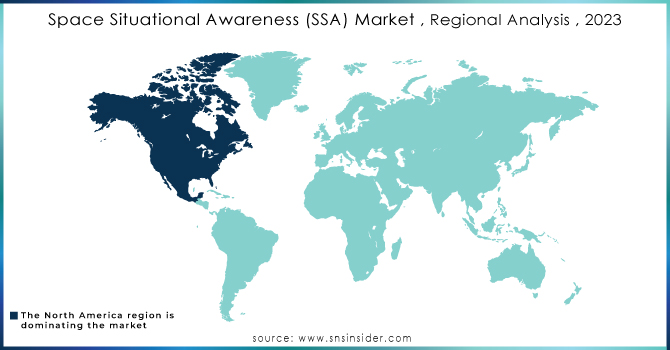Space Situational Awareness (SSA) Market Report Scope & Overview:

To get more information on Space Situational Awareness (SSA) Market - Request Free Sample Report
The Space Situational Awareness (SSA) Market size was valued at USD 1.64 Billion by 2023 and is expected to grow further at USD 2.43 billion by 2032 registering a 4.5% CAGR during the forecast period 2024–2032.
The Space Situational Awareness sector is concerned with the notion of watching and comprehending the earth's climate and space layers. This is accomplished through broadening our comprehension of current knowledge and exploring instruments. The SSA Market, on the other hand, is expanding its capabilities with newer technology and instruments for exploration and observation. The market is concerned with comprehending space conditions, changes, celestial occurrences, and other happenings in outer space. The Market also works with space surveillance, so that the current threats and concerns in space, such as asteroids and unnatural changes, are known. The market also raises our awareness of the unintentional or intentional damage of space networks and satellites.
MARKET DYNAMICS
KEY DRIVERS
-
The low operational costs of small satellites make them suitable for situational awareness applications.
-
The demand for RF mapping, weather monitoring, GPS-radio occultation (GPS-RO) remote sensing, and automatic dependent surveillance-broadcast.
-
These satellites are also used to track ships and monitor suspicious activities in coastal areas.
RESTRAINTS
-
The orbital slots for satellites and radio frequencies are being used by satellite operators
-
To launch low-orbiting satellites by private players to offer global Internet connectivity.
-
Current ITU rules are not in favor of deploying small satellites in orbit
OPPORTUNITIES
-
The continuous advancements in small satellite technologies
-
the growing demand for LEO-based services
-
The demand for LEO-based services may also trigger the demand for space situational awareness services
CHALLENGES
-
One of the major factors that cause orbital debris is object breakup.
-
This debris poses a threat to present and future space missions
THE IMPACT OF COVID-19
The COVID-19 epidemic has wreaked havoc on the world's economic activities. The development of aerospace awareness programs, ground systems, and components has also had an impact. Disruption of the supply chain has led to the suspension of current production processes. Resumption of production activities depends on the level of exposure to COVID-19, the level at which production operations are performed, and the import and export regulations, among other factors. While companies may still take orders, delivery schedules may not be adjusted.
Situational Awareness in Space Market segmentation encompasses the area's several industrial sectors. The examination of industrial categories offers a thorough understanding of market product trends and leading production trends. For better segmentation, the market is divided into offers and end-users. The Space Situational Awareness market is divided into two categories: services and software. For example, the services industry includes space weather services, observation, and surveillance services, among other things. The market is divided into software categories such as orbit determination tool kits, space data and centres, space event generators, and so on. By end-user, the market is divided into commercial applications and military and government applications.
REGIONAL ANALYSIS
Regional Situational Awareness in Space Market Analysis allocates resources and money to different parts of the world. Global income for the industry is generated by several geographical marketplaces across the world. The market is divided into North America, Asia Pacific, the Middle East, Africa, and Europe. The North American area will have the biggest industry share. During the Market Forecast period, the European sector will have the second-largest market share. The Asia Pacific area, on the other hand, will develop the quickest in the next years. Other regional markets will experience rapid expansion in the coming years.

Need Any Customized Research on Space Situational Awareness (SSA) Market - Enquiry Now
KEY PLAYERS
The Major Players are L3Harris Technologies, Lockheed Martin Corporation, Kratos Defense & Security Solutions, Inc., Parsons Corporation, Peraton and Other Players.
| Report Attributes | Details |
|---|---|
| Market Size in 2023 | US$ 1.64 Billion |
| Market Size by 2032 | US$ 2.43 Billion |
| CAGR | CAGR of 4.5% From 2024 to 2032 |
| Base Year | 2023 |
| Forecast Period | 2024-2032 |
| Historical Data | 2020-2022 |
| Report Scope & Coverage | Market Size, Segments Analysis, Competitive Landscape, Regional Analysis, DROC & SWOT Analysis, Forecast Outlook |
| Key Segments | • By Solution (Services, Payload Systems, and Software) • By Orbital Range (Near-Earth and Deep Space) • By End Use (Commercial, and Government & Military) • By Object • By Capability |
| Regional Analysis/Coverage | North America (USA, Canada, Mexico), Europe (Germany, UK, France, Italy, Spain, Netherlands, Rest of Europe), Asia-Pacific (Japan, South Korea, China, India, Australia, Rest of Asia-Pacific), The Middle East & Africa (Israel, UAE, South Africa, Rest of Middle East & Africa), Latin America (Brazil, Argentina, Rest of Latin America) |
| Company Profiles | L3Harris Technologies, Lockheed Martin Corporation, Kratos Defense & Security Solutions, Inc., Parsons Corporation, and Peraton, among others |
| DRIVERS | • The low operational costs of small satellites make them suitable for situational awareness applications. • The demand for RF mapping, weather monitoring, GPS-radio occultation (GPS-RO) remote sensing, and automatic dependent surveillance-broadcast. • These satellites are also used to track ships and monitor suspicious activities in coastal areas. |
| RESTRAINTS | • The orbital slots for satellites and radio frequencies are being used by satellite operators • To launch low-orbiting satellites by private players to offer global Internet connectivity. • Current ITU rules are not in favor of deploying small satellites in orbit |

